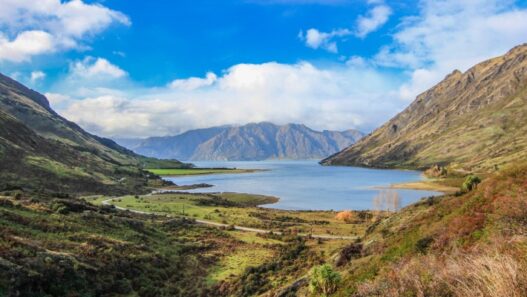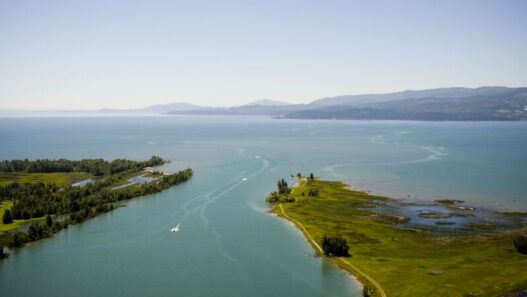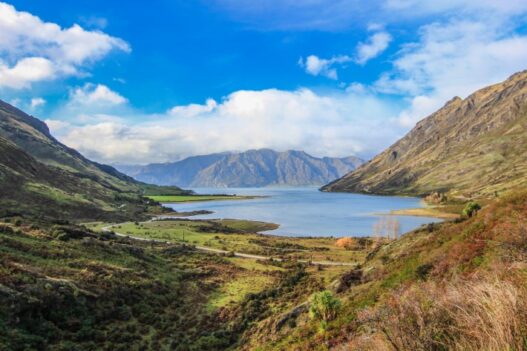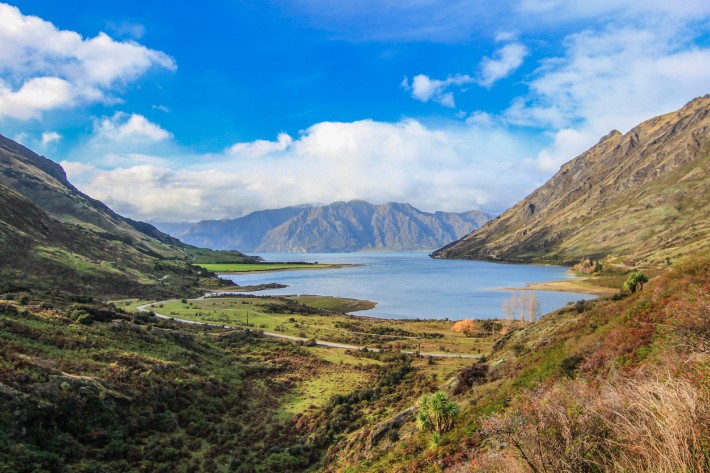New Zealand is one of those rare destinations that can mesmerise you no matter when you visit.
From snow-capped mountains in the South Island to sun-drenched beaches in the North, there's a perfect time for every type of traveller.
Whether you're chasing outdoor adventures, wildlife encounters, or cultural festivals, timing your trip can make all the difference.
Some seasons are ideal for hiking and skiing, while others are better for relaxed beach days or exploring charming towns.
In this guide, we'll break down the best times to visit New Zealand by season, region, and activity so you can plan your adventure with confidence.
For a deeper dive into must-see spots and hidden gems, check out our local guide to exploring New Zealand. After all, I've spent 6 months living, working and travelling all around this beautiful country!
By the end, you'll know exactly when to go to match your interests, whether you're a thrill-seeker, a nature lover, or someone just wanting to unwind amidst stunning scenery.
Understanding New Zealand's Seasons
New Zealand's climate is as diverse as its landscapes, and understanding the seasons is key to planning your trip. Each season brings unique activities, weather, and scenery, so choosing when to visit depends on what kind of experience you're after.
Southern Hemisphere Seasons
One of the first things to know is that New Zealand sits in the Southern Hemisphere.
That means the seasons are flipped compared to Europe or North America. When it's summer in London, it's winter in Auckland.
New Zealand has 4 distinct seasons, each offering a completely different experience. Whether you're chasing sunshine, snow, or serenity, timing your trip right can completely transform it.
From the subtropical warmth of the North Island to the alpine chill of the South, the shift in seasons shapes everything — from what you wear to what adventures await.
Summer (December – February)
brings long, sunny days, perfect for beaches and hiking. It's the season of road trips, barbecues, and golden evenings by the coast. Expect bustling tourist towns, warm ocean swims, and clear trails through national parks. If you love adventure and vibrant energy, this is when New Zealand feels most alive.
Autumn (March- May)
paints the landscapes in gold and is ideal for wine regions and scenic drives.
Winter (June – August)
is peak ski season in the South Island, while spring (September – November) bursts with wildflowers and newborn lambs dotting the countryside. Knowing this helps you match your activities to the right time of year.
Summer In New Zealand (December–February)
Dart Stable horse riding in Queenstown
Summer is the most popular time to visit New Zealand, and for good reason. Days are long, sunny, and warm, with average temperatures ranging from 20°C to 30°C/ 68°F to 86°F.
This is the season for outdoor adventures — think hiking the Tongariro Alpine Crossing, kayaking in Abel Tasman, or road tripping through the South Island with windows down.
The landscapes are at their most vibrant, with lush forests, turquoise lakes, and crystal-clear skies.
Whether you're chasing waterfalls, camping under the stars, or taking a dip in natural swimming holes, summer lets you experience New Zealand's wild beauty at full throttle.
The beaches come alive too, from Bay of Islands in the north to Cathedral Cove on the Coromandel Peninsula.
Locals flock to the coast for swimming, surfing, and picnics by the sea.
Coastal towns like Mount Maunganui and Raglan buzz with energy — surfboards strapped to cars, fish and chips by the shore, and the relaxed Kiwi vibe that defines a true New Zealand summer.
It's also festival season, with lively events like Rhythm & Vines and outdoor food markets.
Expect everything from wine tastings in Waiheke Island to open-air concerts and night markets in Auckland and Wellington.
The atmosphere is social and spontaneous — perfect for travellers who love mingling with locals and soaking up the festive spirit.
But keep in mind: summer is peak tourism. Accommodation and campervans sell out quickly, and prices are at their highest. If you're planning a trip, book early to avoid disappointment.
Autumn In New Zealand (March–May)
In Omarama during autumn
Autumn in New Zealand is a sweet spot for travellers. The weather stays mild, with average highs between 17°C and 23°C/ 63°F to 73°F, so you can still enjoy hiking, road trips, and outdoor activities without the summer crowds.
The real highlight is the scenery. Trees burst into fiery shades of red, orange, and gold, especially in Arrowtown, Central Otago, and Lake Wanaka. It's one of the most photogenic times of year, perfect for slower, scenic travel.
Another perk? Fewer tourists. Accommodation prices drop, popular trails feel less busy, and you'll often have vineyards or hot pools almost to yourself.
Autumn blends comfort with quiet beauty, making it a favourite for those who like a calmer pace.
Winter In New Zealand (June–August)
Winter in New Zealand transforms the country into a playground for snow lovers.
The South Island in particular shines, with ski fields in Queenstown, Wanaka, and Mount Hutt drawing both locals and international travellers.
Temperatures drop to 1°C – 12°/C 34°F – 54°F in many regions, but the crisp air and snow-capped mountains make for breathtaking scenery.
It's also the best time for activities like glacier hiking, soaking in hot springs, or spotting whales off the coast of Kaikōura.
Crowds thin out compared to summer, and you'll often find great deals on accommodation and flights. Off the slopes, winter reveals a quieter, more intimate side of New Zealand.
Vineyards offer cozy tastings by the fire, boutique lodges feel extra inviting, and towns like Arrowtown or Tekapo take on a magical glow under frost and starlit skies.
For photographers and peace-seekers, it's the perfect season to see New Zealand's beauty without the summer rush.
For anyone into skiing, snowboarding, or simply experiencing New Zealand's dramatic winter landscapes, this is the season to aim for.
Spring In New Zealand (September–November)
Spring in New Zealand is a refreshing blend of cool mornings and mild afternoons, with temperatures averaging 10°C – 17°C/ 50°F – 63°F.
The landscapes burst into colour as wildflowers bloom and snowmelt fills rivers, making it a beautiful time for photography and hiking.
It's also the season of new life — you'll spot lambs in the countryside and baby seals along the coasts. Across the country, gardens and parks turn into living canvases.
For you, it's one of the most photogenic times to explore, with fewer crowds on the trails and a soft golden light that makes every landscape feel alive again.
Visit the Hamilton Gardens or Christchurch's Botanic Gardens for a riot of tulips and cherry blossoms, or take a drive through Central Otago, where orchards begin to blossom under wide blue skies.
It's also a great season for road trips, as the weather is mild, roads are quieter, and you can easily combine coastal drives with alpine detours — the perfect mix of New Zealand's contrasting beauty.
Festivals like the Alexandra Blossom Festival celebrate this renewal, making spring not just scenic, but spirited.
Adventure seekers will love the white-water rafting opportunities, thanks to fuller rivers, while wine enthusiasts can enjoy the Marlborough and Hawke's Bay regions before peak season hits.
Spring is quieter than summer, offering lower prices and fewer tourists. If you want a balance of outdoor activities and vibrant scenery without the summer crowds, spring is an excellent choice.
Best Time To Visit New Zealand For Budget Travellers
If you're looking to explore New Zealand without breaking the bank, timing is everything. Travelling during shoulder seasons means lower prices, fewer crowds, and a more relaxed experience while still enjoying the country's highlights.
Off-Peak Travel
If you're travelling on a budget, aim for the shoulder seasons: March – May (autumn) and September – November (spring).
During these months, flights and accommodation are noticeably cheaper, and popular attractions are less crowded.
You can enjoy New Zealand's natural beauty and activities without the peak-season prices.
Tours, rentals, and even festival tickets often come at a discount, making it easier to stretch your travel budget.
It's also a great time to experience local culture more authentically, as towns are quieter and you get a feel for daily Kiwi life beyond the tourist hotspots.
Discounts And Deals
Travelling during the shoulder seasons not only saves on flights and accommodation but also opens up a variety of special deals.
Many hotels, hostels, and tour operators offer discounted packages or added perks like free breakfast or activity upgrades.
Booking early is key—especially for popular attractions like Hobbiton, Milford Sound cruises, or glacier tours—because limited slots can still fill up even off-peak.
Keep an eye on airline promotions and package deals; sometimes combining flights and car rentals saves a significant amount.
Best Time For Outdoor Activities In New Zealand
New Zealand is an adventurer's dream, with alpine hikes, beaches, and snowy peaks.
You can stay active year-round, but timing depends on your interests — volcano treks, sunbathing, or skiing.
Here's how to plan for the ultimate outdoor experience in Aotearoa.
Hiking In New Zealand
Breast Hill, New Zealand
The best months for hiking in New Zealand are October to April, when trails are clear of heavy snow and weather conditions are generally mild.
This is when you can comfortably tackle the country's famous “Great Walks,” like the Milford Track, Routeburn Track, and Abel Tasman Coast Track.
If you're up for a challenge, the Tongariro Alpine Crossing is a highlight. Summer offers safe access to its volcanic landscapes and emerald lakes, while spring and autumn provide cooler temperatures and fewer crowds.
Outside these months, some alpine routes can be closed or require specialist equipment.
If you're travelling in winter, stick to lower-altitude trails around places like Queenstown or Wanaka for safe but still stunning hikes.
Beaches And Water Sports In New Zealand
If you're chasing sun-soaked days, December to February is the best time to hit New Zealand's beaches.
With the warmest sea temperatures of the year, it's perfect for swimming, kayaking, and paddleboarding along stretches like Mount Maunganui, Piha, and Cathedral Cove.
Snorkelling and diving are also at their peak in summer.
The Poor Knights Islands in Northland and Goat Island Marine Reserve near Auckland are hotspots, with clearer waters and more marine life activity.
Crowds do swell in these months, so head to hidden bays in the Coromandel Peninsula or the wild beaches of the West Coast if you want space to yourself.
Skiing And Snowboarding In New Zealand
For winter lovers, June to August is when New Zealand transforms into a snowy playground.
The South Island, especially Queenstown and Wanaka, is the heart of the action, with world-class resorts like Coronet Peak, The Remarkables, and Cardrona.
These months bring reliable snow coverage, buzzing après-ski scenes, and plenty of events like winter festivals.
Beyond the slopes, these towns come alive with winter energy — cosy mountain lodges, hot mulled wine, live music, and night skiing under floodlights. You don't have to be a pro to enjoy it; the vibe is social, festive, and welcoming to all skill levels.
Even if you're not skiing, scenic helicopter rides and snowshoeing trails offer incredible alpine views.
The North Island also joins in, with Mount Ruapehu offering slopes on an active volcano — a unique experience you won't find elsewhere.
Whether you're carving down black runs or learning the basics, winter is the perfect season to pair adventure with breathtaking alpine landscapes.
Best Time For Wildlife Experiences In New Zealand
Wildlife in New Zealand is as captivating as its landscapes — whales breaching, penguins waddling ashore, and rare birds singing fill the experience.
Each season unveils something different: winter brings migrating humpback whales along Kaikōura's coast, while summer sees playful dolphins and fur seals in warmer waters. In spring, the Otago Peninsula comes alive with yellow-eyed penguins and albatross nesting, while autumn is ideal for birdwatchers heading into the forests and wetlands.
The best time to spot creatures depends on seasonal migrations and breeding cycles. Visiting Kaikōura for marine life or Otago Peninsula for penguins can be unforgettable.
Best Time In New Zealand For Whale Watching
If spotting giants of the ocean is on your bucket list, June to August is the prime season. During these winter months, humpback whales and southern right whales migrate along New Zealand's coastline, making it the best time to see them up close.
The star location is Kaikōura on the South Island. Its unique deep-sea trench brings nutrient-rich waters close to shore, attracting not just whales but also dusky dolphins, orcas, and sperm whales. The contrast of watching a whale breach with snow-dusted mountains in the background is an experience that feels almost surreal.
Boat tours are the most popular, but you can also spot whales by air with helicopter or light-plane tours that give you a wider view of the marine activity.
Even in winter's chill, the calmness of the sea and the abundance of wildlife make this one of New Zealand's most memorable adventures.
Best Time In New Zealand For Penguin Viewing
Blue Penguin, New Zealand
Source
For penguin lovers, the best window is September to February, when New Zealand's most famous species come ashore to breed and nest.
The rare yellow-eyed penguin (hoiho) can be spotted along the Otago Peninsula near Dunedin, where guided tours take you to secluded hides for a quiet, respectful view of these shy birds.
You'll also find the adorable little blue penguins — the world's smallest — returning to their burrows at dusk in places like Oamaru. Watching them waddle from the surf in tiny groups is both charming and unforgettable.
Many tours operate in the early evening, and it's worth booking ahead — numbers are limited to protect the penguins and their fragile habitats.
Bring warm layers and stay quiet while viewing; the experience feels more like a privilege than a show. Some conservation centres also allow you to learn about rescue and breeding efforts, adding purpose to your visit.
These months coincide with long daylight hours and warmer evenings, making it easier to plan tours without rushing.
For wildlife enthusiasts, it's one of the most rewarding seasonal highlights in New Zealand.
Best Time In New Zealand For Bird Watching
Kea Alpine Parrot, New Zealand
Source
New Zealand is a paradise for bird enthusiasts, with opportunities to spot unique species all year round. From the kiwi to the kea (the cheeky alpine parrot), every region has its star attractions.
Spring (September–November) is especially rewarding, as migratory birds arrive and native species become more active during breeding season.
Wetlands like Miranda Shorebird Centre and predator-free sanctuaries such as Zealandia in Wellington are top picks for spotting rare and endangered birds.
Even outside spring, coastal areas, forests, and national parks offer incredible year-round birding, making it a must-do for nature lovers whenever you visit.
Best Time in New Zealand For Festivals And Events
New Zealand's festivals celebrate culture, music, food, and nature year-round. From summer wine tastings to winter ski carnivals, timing your trip with an event adds extra fun and a chance to enjoy local traditions.
Summer Festivals In New Zealand
If you want to experience New Zealand at its most vibrant, summer (January–February) is the season to plan around. Long days, warm nights, and buzzing energy set the stage for lively outdoor gatherings.
One of the biggest highlights is the Marlborough Food and Wine Festival, where you can sample world-class sauvignon blanc alongside local produce in stunning vineyard settings.
Across the country, local communities celebrate everything from Māori culture to coastal living — think beach carnivals in Mount Maunganui, open-air film nights in Wellington, and art trails in Nelson.
The atmosphere is relaxed but electric, with food trucks, live music, and pop-up markets filling every weekend. It's the perfect time to meet locals and soak up the country's creative spirit.
Music lovers flock to events like Rhythm and Vines in Gisborne, which kicks off the New Year with global DJs and festival vibes.
From wine tastings to beachside concerts, summer is when New Zealand's social calendar is at its fullest, offering travellers a perfect mix of culture, food, and fun under the sun.
Autumn Events In New Zealand
From March to May, New Zealand slows down into a more relaxed yet deeply cultural rhythm. The crowds thin, but the event calendar stays rich with experiences.
This is the season of harvest festivals, especially in wine regions like Hawke's Bay and Central Otago.
Visitors can take part in grape-picking, vineyard tours, and food pairings that celebrate the bounty of the land.
Cultural highlights also shine in autumn, with local arts and heritage events offering a chance to connect with Kiwi traditions.
It's a season that blends community spirit, flavours, and creativity — perfect if you prefer meaningful experiences over big parties.
Winter Festivals In New Zealand
Between June and August, New Zealand transforms into a winter wonderland, and the festivals match the energy. The biggest highlight is the Queenstown Winter Festival, which kicks off the ski season with fireworks, live music, and snow sports competitions.
In the South Island, alpine towns like Wanaka and Methven also host snow-themed events, combining local culture with mountain vibes. Expect everything from ice bars to après-ski parties, making it just as lively off the slopes as on them.
For travellers who love crisp mountain air, cosy nights, and a festive winter buzz, this is the time to visit.
Spring Events In New Zealand
From September to November, New Zealand bursts back into colour, and the festivals celebrate just that.
One of the most famous is the Taranaki Garden Festival, where private and public gardens open their gates to showcase incredible spring blooms.
In Christchurch, outdoor concerts and cultural events take advantage of the warming weather, often spilling into the city's parks.
It's also a season of food and wine festivals in smaller towns, giving you a taste of New Zealand's local produce.
Spring festivals have a laid-back vibe, perfect for travellers who prefer fewer crowds but still want lively experiences.
Tips For Planning Your New Zealand Trip
Planning a trip to New Zealand requires foresight. Popular spots book up fast, so reserve accommodations early. Pack layers and waterproof gear, and always have travel insurance for unexpected delays or emergencies.
Booking Accommodations
During summer (December – February) and school holidays, popular spots like Queenstown, Rotorua, and the Bay of Islands can fill up fast.
It's wise to book hotels, lodges, or Airbnbs well in advance to secure the best rates and locations.
If you're travelling during peak season, consider mixing hotel stays with campervan rentals or boutique lodges — it gives you flexibility and lets you experience New Zealand's stunning landscapes up close.
Smaller towns often have charming B&Bs or eco-lodges that provide a more authentic local touch.
Even in shoulder seasons, advance planning helps snag better deals and flexible cancellation options.
Packing Tips
New Zealand's weather can be unpredictable, even in summer. Layered clothing is a must—think t-shirts, fleeces, and waterproof jackets.
For the West Coast and mountain regions, pack a good rain jacket and sturdy footwear for hikes and outdoor adventures.
Don't forget sun protection for the beaches and sunglasses, as UV can be strong year-round.
Travel Insurance
No matter when you visit New Zealand, having comprehensive travel insurance is essential.
It covers medical emergencies, trip cancellations, lost luggage, and adventure activities like hiking, skiing, or water sports.
Even minor mishaps in remote areas can become costly, so securing a policy before departure is a smart move for peace of mind.
Staying Connected In New Zealand
Mobile coverage in New Zealand can vary, especially in remote or alpine regions.
To stay connected seamlessly, consider using an eSIM — it's the easiest way to access local data without hunting for a physical SIM card.
eSIMs let you activate a local plan before landing, use maps, book tours, and share travel updates instantly.
For detailed comparisons and recommendations, check out our full guide on the best eSIM for New Zealand.
FAQs Regarding Visiting New Zealand
What Is The Cheapest Time To Visit New Zealand?
The most budget-friendly time to visit is during the shoulder seasons: March – May (autumn) and September – November (spring).
During these months, flights and accommodation prices drop significantly compared to peak summer (December–February).
Fewer tourists mean lower rates for tours, car rentals, and attractions, making it ideal for travellers looking to explore New Zealand without breaking the bank.
Just keep in mind that some weather-dependent activities, like skiing or certain boat tours, may be limited during these periods.
What Is The Rainy Season In New Zealand?
New Zealand doesn't have a single, uniform rainy season—it varies by region.
The West Coast of the South Island sees the most rainfall year-round, while North Island regions like Auckland and Wellington get frequent showers in winter (June – August).
Generally, May through August tends to be wetter across much of the country.
If you're planning outdoor adventures like hiking or beach activities, it's best to pack waterproof gear and check regional weather forecasts before heading out.
What Month Is It Warm In New Zealand?
The warmest months in New Zealand are December through February, which is the Southern Hemisphere summer.
During this period, temperatures typically range from 20°C to 30°C/ 68°F – 86°F in most regions, making it ideal for beaches, swimming, hiking, and other outdoor activities.
The North Island tends to be slightly warmer than the South Island, while coastal areas enjoy more temperate conditions compared to inland regions.
This is also when daylight lasts up to 15 hours in some areas, giving you plenty of time for road trips, scenic hikes, or long evenings by the beach.
Popular holiday spots like the Bay of Islands, Coromandel, and Nelson are especially vibrant, with bustling markets, outdoor dining, and festivals filling the summer air.
How Many Days Do You Need to See All Of New Zealand?
To explore both the North and South Islands thoroughly, most travellers need at least 2 to 3 weeks.
This gives enough time to experience major highlights like Auckland, Rotorua, Wellington, Queenstown, Fiordland, and the Southern Alps without feeling rushed.
If you're short on time, a 10–14 day trip can still be incredibly rewarding by focusing on just one island — either the geothermal wonders and Māori culture of the North Island or the alpine scenery and adventure towns of the South.
If you prefer a more relaxed pace, especially if you want to include hikes, scenic drives, wine regions, and off-the-beaten-path spots, 3–4 weeks lets you truly immerse yourself in the country's rhythm and natural beauty.
If you're planning your route, this 2-week South Island itinerary gives you a feel for what it's like to travel through New Zealand like a local in this insider guide — both are great starting points for mapping out your adventure.
New Zealand truly offers something for every traveller, but the best time to visit depends on what you want to do.
Each season paints the country in a completely different light — from golden beaches and alpine peaks to blooming valleys and cozy winter towns.
There's truly no wrong time to visit; it's all about choosing the version of New Zealand you want to experience.
Summers (December–February) are perfect for beaches and water sports, winters (June–August) for skiing and snow adventures, while spring and autumn are ideal for hiking, wildlife spotting, and enjoying festivals with fewer crowds.
Consider your personal interests and priorities when planning your trip.
Whether you're chasing adventure, scenic landscapes, or cultural experiences, aligning your visit with the right season makes all the difference.
For more inspiration and detailed itineraries, check out our full New Zealand Travel Guide to start planning your ultimate journey.












